‘Deliberate secrecy’: Sydney radioactive site cleaned up after a century of delay
Residents recall idyllic childhoods, playing by the Parramatta River foreshore and working in vegetable gardens. What they didn’t know was the extent of radiation contamination that has only now been cleaned up.
By Ben Cubby
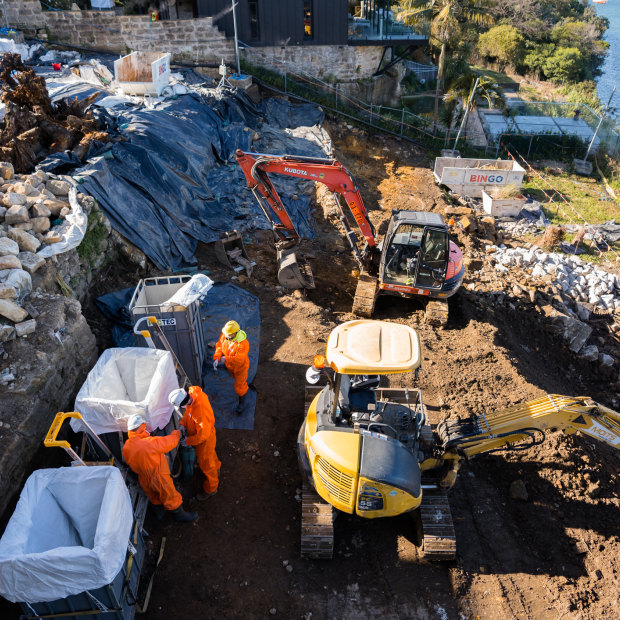
Workers at the Hunters Hill contamination site.Credit: NSW Government
Radiation doses over four times legal levels were detected during the clean-up of suburban blocks in Hunters Hill, on the site of a former uranium refinery that several state governments had repeatedly declared “safe”.
Over 3000 cubic metres of contaminated material has now been removed from waterfront blocks in Nelson Parade – some shipped to a troubled nuclear waste storage facility in the US, the remainder trucked to a remote site in Western Australia. The government is set to announce on Thursday that the three-year clean-up is complete.
A Herald investigation has uncovered a pattern of secrecy surrounding the site for much of the past century. Some former residents were lied to about potential health risks, bags of contaminated dirt were left piled on the foreshore where children played on them, and barrels of radioactive material dug up in the 1990s and believed lost somewhere in Sydney were quietly being stored at a facility in Lidcombe for 30 years.
People on the site during the clean-up were exposed to the equivalent of 4.5 millisieverts – a unit of measurement for radiation doses – per year. The limit for public exposure is 1 millisievert per year, according to annual dose limits prescribed by the Australian Radiation and Nuclear Safety Agency.
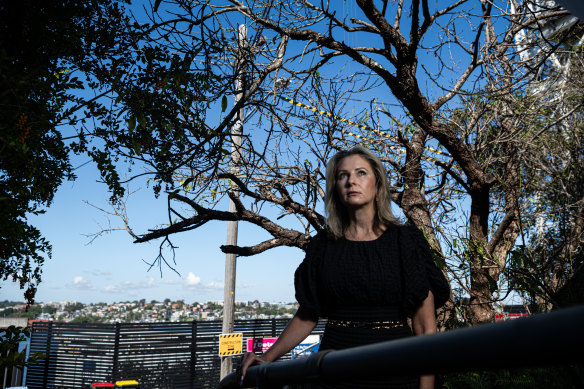
Katie McGrath lost both her parents to cancer in their 30s when she was aged five. She believes the former uranium refinery on her childhood street is responsible.Credit: Nick Moir
Some patches of radioactive earth were almost three times higher than the level required to be classified as hazardous waste, the government confirmed.
“The new information is startling in many ways but confirms my long-held concerns that the site was too radioactively contaminated for residential properties,” said Dr Gavin Mudd, a radiation specialist formerly with Monash University who gave expert evidence during a NSW parliamentary inquiry into the site in 2008.
The health risks caused by the radiation – which can damage cells and cause cancer - remain unclear. The government’s consistent position has been that there is no known link between the radioactivity at the site and health problems of people nearby.
The most heavily contaminated area has been fenced off for decades and houses surrounding the three most polluted residential blocks were tested repeatedly during the clean-up and found to have relatively low levels of radioactivity – well below levels of concern.
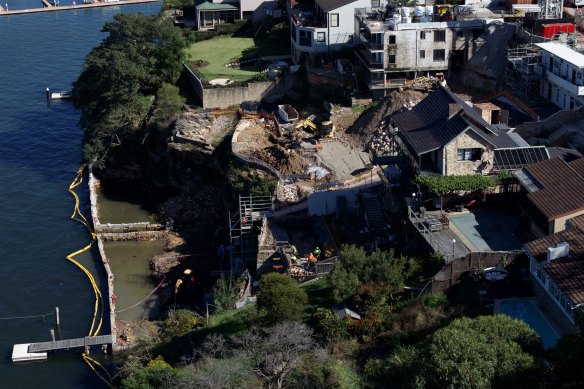
Nelson Parade during the clean-up, in which some patches of earth were found to be nearly three times higher than the level to be classified as “hazardous”.Credit: Nick Moir
But a string of cancer deaths among people exposed to the site during the 1960s, 1970s and 1980s raised fears among some residents that the residues of the former uranium refinery in the soil were to blame.
Katie McGrath’s parents, Iris and Fabian, both died of cancer a few months apart while in their 30s, leaving her an orphan at age five. The family lived several properties down the road from the polluted site, in an area now free of contamination, though her father built a retaining wall with soil that may have come from the former refinery site and the family spent much time on the contaminated areas.
No one warned the family of the radiation before they bought their home, even though the state government had previously run tests and found alarming levels of radioactivity in neighbouring properties.
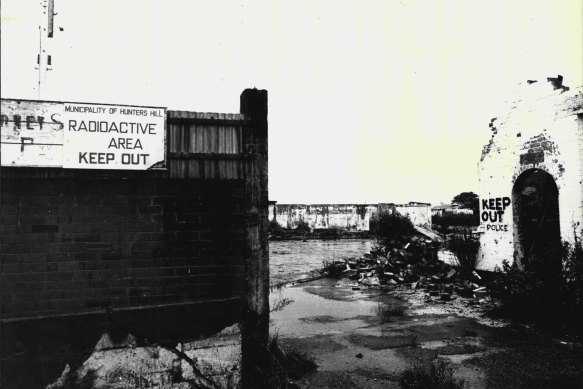
A historical photo of contamination sites at Hunters Hill.Credit: Fairfax Media
“There was deliberate secrecy,” said McGrath, who was unaware of contamination in her childhood street until she read a Herald article in 2008. “The government had an obligation to share this information.
“I think the government acted to clean it up because they were under extreme pressure from the community and they really had no other option,” she said. “I’ve got to give them credit for having done that. But it doesn’t change the past for me, it doesn’t change the fact that the risks were hidden and it took 40 years to acknowledge the problem.”
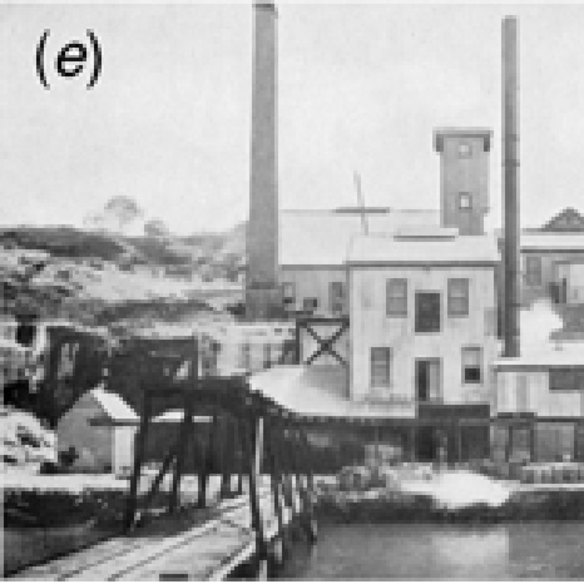
Historical photo showing the uranium refinery on Fern Bay, near the future Nelson Parade.
The affected properties are undergoing a final audit by contractors and the NSW Environment Protection Authority. They are then expected to be sold off as private housing, bringing an end to a saga that started in 1911 when barrels of uranium ore were first unloaded on the Hunters Hill dock.
Secrecy and radium slime
Building a uranium refinery on what was to become one of the city’s more prestigious residential streets was a direct result of early attempts to treat and cure cancer.
Radium, a naturally occurring radioactive metal, was seen as having huge potential for radiation-based cancer treatments. For a time it was in high demand and literally worth hundreds of times its weight in gold.
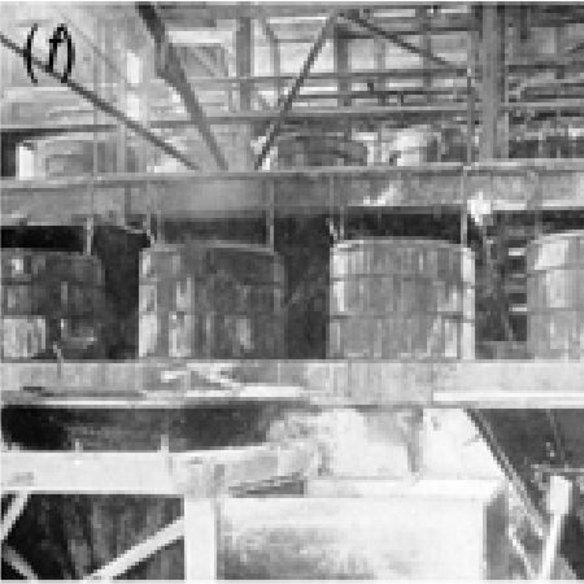
Historical photo showing inside the Hunters Hill uranium refinery.
The Radium Hill Company established its Nelson Parade refinery in 1908 and started operating three years later, shipping enriched uranium ore from South Australia and processing it in vats of acid to extract radium for export to Europe.
It processed around 2150 tonnes of uranium, producing about seven tonnes of yellowcake slurry and about 1.8 grams of radium bromide – the weight of two paperclips. Some of the processing byproducts were used to paint watch faces that glowed in the dark, or used as ceramic glazing – some of the distinctive orange tiles in Sydney’s Downing Centre court complex allegedly used glaze from the site.
The company went bust in 1915. The health risks of radiation were not well understood, and houses were built across much of the area even though hundreds of tonnes of uranium tailings were mingled in the soil.
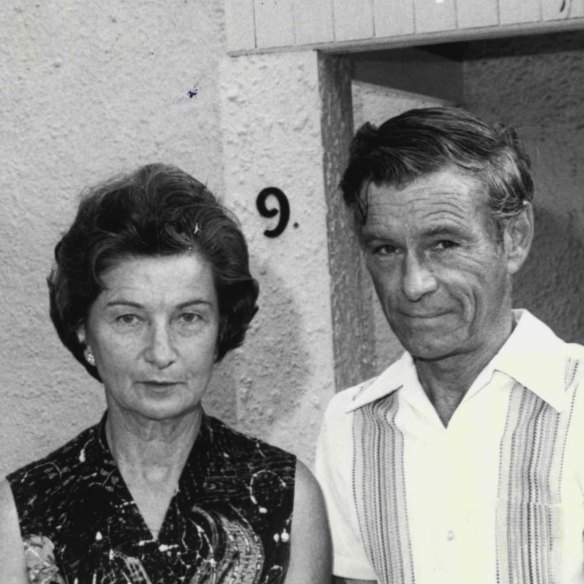
Joan and Gerald Conlan outside their Nelson Parade home in 1978.Credit: Thomas/Fairfax Media
Early reports described fine grey powder in the soil, thought to be the residue of “radium slimes”. A “black micaceous material” was found in the earth that was thought likely to be pieces of uranium ore. Residents, unaware of the risks, dug in the soil, built retaining walls and grew vegetables.
By the mid-1960s, authorities were becoming alarmed as evidence mounted globally of the long-term health impacts of radiation exposure. Health Department officials visited the site with Geiger counters but concluded the risks were manageable and the test results were not made public.
Former resident Joan Conlan moved into the street with her husband Gerald in 1962 without being aware of the contamination. Tests were undertaken on their property at number 9 Nelson Parade in 1965, but she was notified by letter that “the health hazard is at present negligible”, she told the parliamentary inquiry. In 1972 Gerald was diagnosed with leukaemia. He died of related symptoms in 1987.
Cancer and bags of dirt
“At the base of our property, a huge mound of bags approximately three metres high kept me amused for hours on end,” wrote Julienne Nurse, who lived with her family on number 11 when she was a young girl between 1974 and 1980. “These bags were damaged with soil spilling out of them. There were no labels identifying their content.”
The bags contained some of the most hazardous radioactive waste found on the site during a partial clean-up.
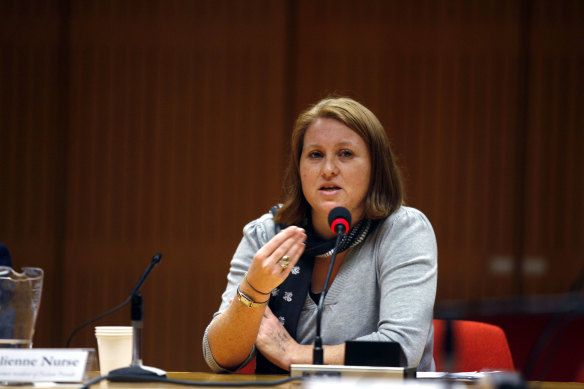
Julienne Nurse gives evidence at a parliamentary inquiry in 2008.Credit: Jon Reid
“I have watched my sister being diagnosed with thyroid cancer … I constantly wonder whether this was due to our exposure as children to radiation and, if so, will I be next,” she wrote in a submission to the inquiry. “I remember being told by my mother not to play on the bags anymore, but I continued nonetheless.”
Nurse’s mother, former High Court judge Mary Gaudron, was alarmed by her next-door neighbour Gerald Conlan’s leukaemia diagnosis and began calling government officials.
An internal health department memo from 1977 said staff should “please stall and be non-committal” when contacted by residents. Gaudron was requesting radiation testing for her family but “no action has to be taken on this matter until further advised.”
Radiation testing should be continued in the street, the memo said, “provided that in doing so we do not conspicuously draw attention to ourselves and we do not discuss the matter with other persons, such as the council, until further advised.”
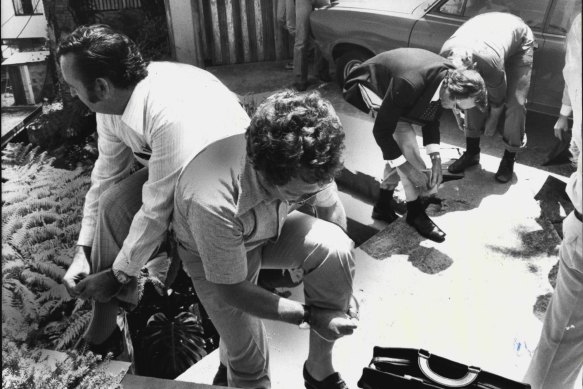
Union officials and anti-uranium campaigners visited the site in the 1970s. They are seen rolling up their trouser cuffs before entering the site.Credit: Grant Peterson/Fairfax Media
Around this time, McGrath’s mother Iris began to fall ill. In her book Deadly Earth, McGrath recounts an idyllic early childhood with her family on Nelson Parade, playing with her brothers by the foreshore as her parents worked in the vegetable garden.
Iris McGrath died of stomach cancer in 1975 and her husband, Fabian, of leukaemia in 1976. Katie McGrath and her brothers went to live with a distant relative who abused the children for many years.
“My parents just got wiped out,” she said. “We were never told even though the government knew there were risks. I believe contamination on this site not only contributed to the death of my parents, but it set in place a really significant chain of events which led to years of abuse.”
‘No evidence’ of health risk
The state government’s position has always been that no cancer deaths can be attributed to radiation on the street.
“In 2008, NSW Health presented evidence at a parliamentary inquiry that there was no evidence to suggest an increase in deaths from cancer or potential radiation-related illness in Nelson Parade as compared to the rest of Hunters Hill”, said a spokesperson for the NSW Department of Planning, Housing and Infrastructure, which assumed management of the site during the clean-up.
“This evidence included maps produced by the Cancer Council which showed no concentration of cancer-related deaths in Hunters Hill. The inquiry also heard council representatives refer to a census which did not suggest there were increased rates of cancer within Hunters Hill.”
The 2008 inquiry heard that five people from the street who had contact with the former uranium refinery site had died of cancer.
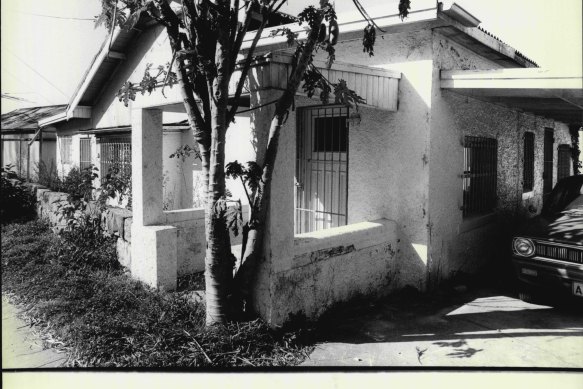
One of the homes on Nelson Parade that was bought back by the government and demolished due to radiation risks.Credit: Trevor James Robert Dallen/Fairfax Media
Associate Professor Tilman Ruff of Melbourne University, a public health expert who gave evidence at the inquiry, said pinpointing the cause of individual cancer cases in the street would be nearly impossible.
“It is difficult because low dose exposure to radiation broadly increases risk of cancer and other diseases, but there’s no test that can flag that a particular cancer was caused by radiation,” he said.
“About a third of people in Australia die of cancer, so to have a third of the people in a street die of cancer is not an unusual number.”
The dose rate of 4.5 millisieverts a year detected during the clean-up is well over double the average annual dose rate received by workers at the Lucas Heights nuclear reactor in Sydney’s south, and far more than most people evacuated during the Fukushima nuclear meltdown in 2011 were exposed to.
It is the equivalent for a male adult of getting about 250 chest X-rays a year - probably safe but with potential to lead to small but measurable increases in cancer rates, Ruff said. The risks are higher for women and children.
But most residents the Herald spoke to were unconvinced by claims the site had caused a cancer cluster.
“We’ve been involved enough to know that there’s almost zero risk,” said one Nelson Parade resident who lives near the contaminated site. “There’s been a huge amount of misinformation, especially around the idea of a cancer cluster. ANSTO has been sampling up and down the street. There have been higher than background readings but nothing that is particularly dangerous.”
‘Missing’ drums and alleged threats
By the 1980s, it was obvious that the contaminated land needed to be rehabilitated. The problem was finding a way to transport and store the waste.
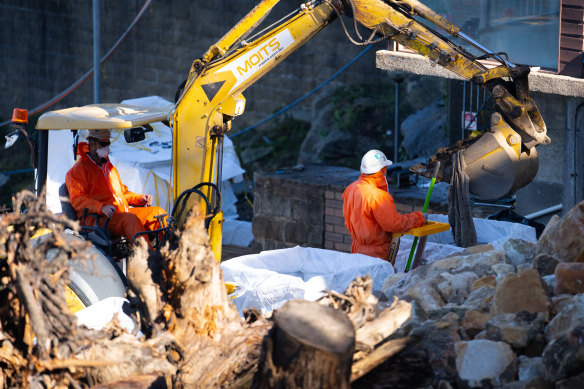
Clean up operations at the Hunters Hill site.
Some of the most hazardous dirt had been scraped into steel drums in 1992, but the paperwork showing what was in the drums and where they were taken was lost. “We do not know precisely where it went to,” a senior environment department official told the parliamentary inquiry.
The Herald has learned that the drums of radioactive material thought to be missing had been “temporarily” stored for almost 30 years in a concrete room in a NSW Environment Protection Authority building in Lidcombe.
Why the EPA didn’t share this information with the inquiry is unclear. When a political furore erupted in 2011 over the mooted transfer of waste from Nelson Parade to Lidcombe, the EPA also failed to point out that some of the radioactive dirt was already there. A spokesperson for the EPA said information was provided to the inquiry in “good faith”.
The government has also faced allegations it attempted to keep media coverage of the site quiet. McGrath says she was visited at her workplace by an EPA staff member who told her to stop speaking to the press.
“He said: ‘We will keep you across all the plans to remediate the site if you stop talking to the media’.” McGrath said. “He started to get really aggressive, he said ‘I’m not asking, I’m telling you’. It was awful.”
The EPA said it has no record of the incident and did not make attempts to quash media coverage. “If such an incident occurred, this would have been outside the staff member’s role and contrary to our organisation’s values,” a spokesperson said.
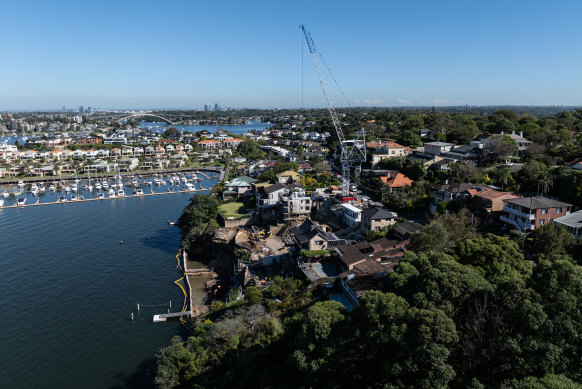
View over the site and up Parramatta River.Credit: Nick Moir
Finally, after several aborted attempts to get a large-scale clean-up under way, the government decided in 2021 to push ahead with a plan to carve thousands of tonnes of soil from the Nelson Parade properties and send it overseas for permanent storage.
“The residents of Nelson Parade were promised that a safe and secure remediation solution to the contamination issue would be delivered,” a Department of Planning spokesperson said when asked why the site was being cleaned up when the government had repeatedly declared it safe.
“The current NSW government has continued to honour that commitment and have undertaken this remediation program to ensure the stigma of radiological impact on the Nelson Parade residential properties is removed once and for all.“
‘Perfect environmental record’
American firm US Ecology gained the contract for transporting the waste across the Pacific for storage at a large containment site for radioactive and toxic chemical waste near the town of Grand View in the state of Idaho.
“The company has maintained a perfect environmental compliance record for the import of radioactive materials”, it said in its management plan for the Hunters Hill waste, lodged in 2021.
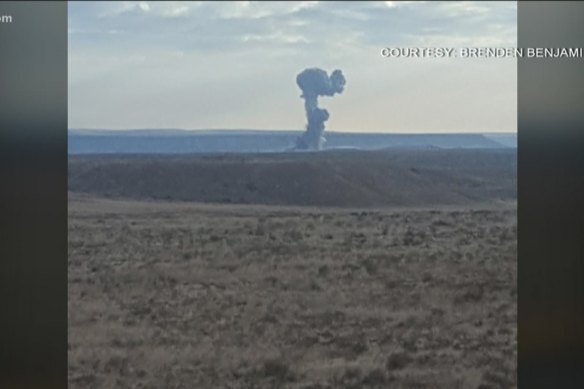
An image showing an explosion at the Grand View waste facility in Idaho in 2018.Credit: KTVB
However, its safety record wasn’t quite perfect. In November 2018, a witness driving past the Idaho site saw “a big huge red ball explosion that kind of caved in, a big mushroom of smoke”. One worker was killed and three injured by a blast apparently caused by a chemical reaction between materials brought into the site for treatment and storage.
Questions have also been raised about high levels of radioactivity detected in the air and water around the Grand View site.
“The US Ecology Idaho facility is causing widespread airborne radioactive contamination of south-west Idaho”, according to a regional environmental monitoring group, the Environmental Defense Institute, citing spikes in radioactivity measurements near the site.
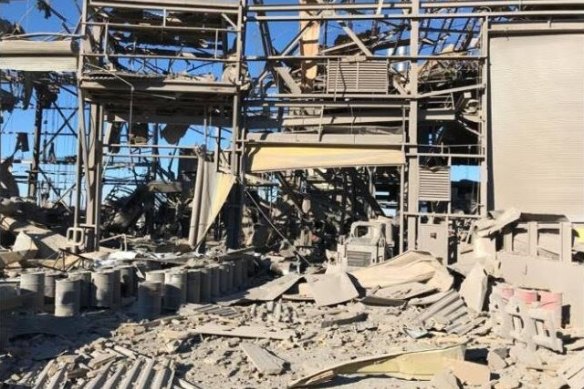
Wreckage at Idaho’s Grand View waste facility after an explosion that killed a worker in 2018.
The US Environmental Protection Agency lists a string of minor compliance faults for the US Ecology complex, and the company was fined $US184,000 in 2012 for failing to report toxic releases at the Grand View site, but there is no independent confirmation of widespread radiation leaks.
When asked about the Idaho site’s safety history, a NSW Planning spokesperson said: “The USA facility where the Nelson Parade material was taken meets all USA and international standards for safe waste treatment and disposal.”
Stored in the desert
Almost immediately, the plan to transport the contaminated material from Hunters Hill ran into logistical problems.
The owners of a yard in Port Botany where the waste was to be stored, Henroth Group, threatened legal action, forcing a change of plan. A new strategy to take it by rail to Adelaide before being shipped to the US was thwarted when it was realised that the storage area was not licensed to hold the material.
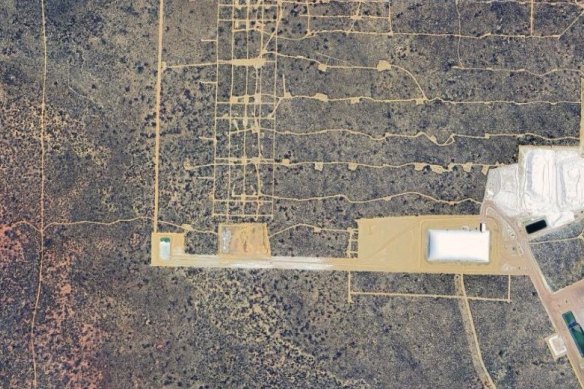
An aerial view of the Sandy Ridge facility in Western Australia where some of the Hunters Hill waste was sent.Credit: Google
Then the Chullora rail hub in Sydney, where the waste would be transferred from trucks to begin its rail journey, was found to be without a license to handle the material. The EPA noted that “a number of matters … appear to be inconsistent with the lawful management and movement of the waste,” planning documents show.
Eventually, a total of 139 containers packed with Hunters Hill soil were sent to Idaho, but delays and escalating shipping costs forced the government to change plans yet again. Bagged waste was backing up in Hunters Hill, and the Lucas Heights complex, which was being used for temporary storage, could take no more.
A new facility in the West Australian desert, about 200 kilometres north-west of Kalgoorlie, received a license in January 2023 to take radiological waste, and the government decided to stop sending the waste overseas.
The facility at Sandy Ridge, owned by Tellus Holdings, received the last truckloads of contaminated earth from Nelson Parade earlier this year.
The Minister for Lands and Property Steve Kamper said: “This is a great outcome for the people of Nelson Parade and the local environment, and a major achievement for Property and Development NSW which has worked for many years to find the best solution to clean up the land and safely remove the contaminated waste.
“We will now begin work to make the land available to families to call Hunters Hill home.”
McGrath said she was not seeking compensation from the government for not telling families about the potential risks, but that she would like an apology. She has previously sought one and was rebuffed.
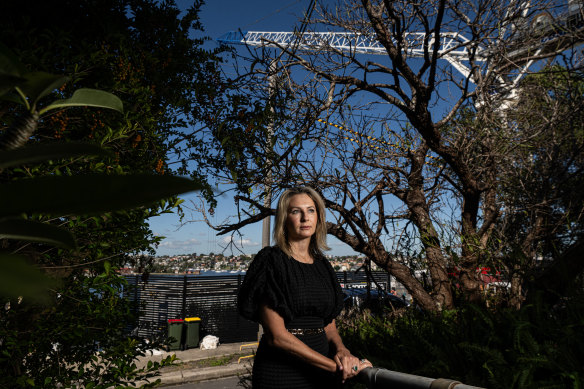
Katie McGrath says there has been no apology from the government.Credit: Nick Moir
“There’s been no apology. Never. And I asked for one specifically,” she said. “There’s been no acknowledgment of what we suffered.”
Associate Professor Ruff said it was astonishing that the situation had dragged on for so long when the public health risks had been known for decades.
“There’s a long history of bureaucratic buck-passing, incompetence, secrecy and dysfunction at this site,” Ruff said. “It should have been cleaned up when the problem was diagnosed. People should never have been allowed to live there.”
The Morning Edition newsletter is our guide to the day’s most important and interesting stories, analysis and insights. Sign up here.